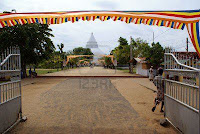Location of Tissamaharama
Tissamaharama is located 270km south of Colombo.
Reaching Tissamaharama
Tissamaharama can be reached by A2 southern main road
travelling via Galle and Hambantota.
Tissmaharama Town
Though Tissamaharama is visited mainly in view of it being
the gateway to Yala National Park, Tissa as it is affectionately called, in its
own right, is a major cultural and nature attraction. Three ancient stupas and
two ancient irrigation reservoirs make Tisssamaharama worth touring. On the northern
side, the town is bounded by lovely expanse of paddy fields. In the middle of
the paddy fields is Santagiri or Sandagiri dagaba, the largest stupa at
Tissamaharama.
History of Tissamaharama
Tissamaharama known by the name of Mahagama in the ancient times
was founded by Prince Mahanaga, brother of King Devanampiyatissa in the third
century BC. The settlement rose to prominence during the reign of King
Kavantissa, father of King Dutugamunu. It was during this period that
Tissmaharama’s three stupas and the two ancient irrigation reservoirs were
built. According to the chronicles, around 12,000 Arahats Buddhist monks had
lived in Tissamaharama and its surroundings during the era of King Kavantissa.
During the era in which the monasteries flourished in the
ancient Rajarata of north central plains, many a similar monasteries and dagaba
were built in Magama, the capital of the southern region of Sri Lanka.
Tissa weva Reserervoir in Tissamaharama
Just a kilometer north of the Tissmaharama town spreads the vast
ancient irrigation reservoir called Tissa wewa. The shore of the lake nearest
to the town of Tissamaharama is regularly crowded with the villagers and the
tourists. The massive embankment that bounds the southern shore of the
reservoir is line by trees. To the east of the far end of Tissa weva reservoir
is another man-made irrigation reservoir called Debera Weva. Both reservoirs
are havens for bird life.
Santagiri or Sandagiri dagaba in Tissamaharama
Sandagiri stupa was built by the regional ruler Prince
Mahanaga in the third century B.C. Sandagiri stupa is 55m in height and 165m in
circumference. According to the chronicles, around 12,000 Arahats have lived in
the Tissa area during the life and times of King Kavantissa who, deposited the
forehead relic of the Buddha in Sandagiri stupa.
Historical chronicles narrates that some of the various
relics and gifts sent by Emperor Asoka to King Devanmpiyatissa (250-210 BC) of
Sri Lanka were enshrined in the Sandagiri Stupa of Ruhuna. However, the first
provincial ruler to have begun the construction of sacred places of Buddhist
worship in Ruhuna was Mahanaga. Historical chronicles narrate that Buddha, in
his third visit to Sri Lanka arrived at Tissamaharama and hence the ancient
settlement is considered sixteen sacred locations of the island.
Yatala dagoba in Tissamaharama
A short stroll along the road from the southwest corner of
Tissa weva is Yatala dagoba and further down about half a kilometer is Menik
dagoba. The small cluster of pillars located in the midway are the ruins of an
ancient monastery called Galkanunmandiya. Yatala Dagoba that has been
identified as Mani Chethiya and Yattalaya in various historical documents was
built by Prince Mahanaga in the 3rd century BC.
Picture gallery of Tissamaharama




No comments:
Post a Comment